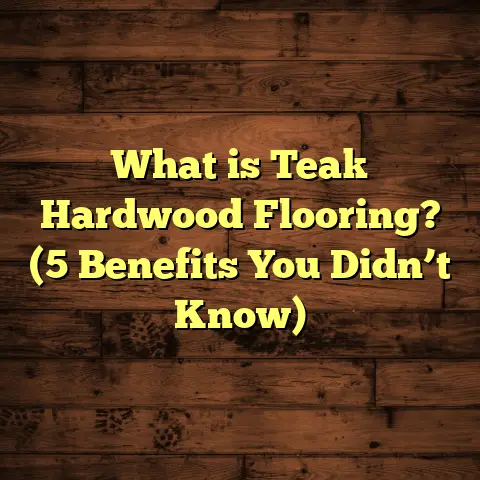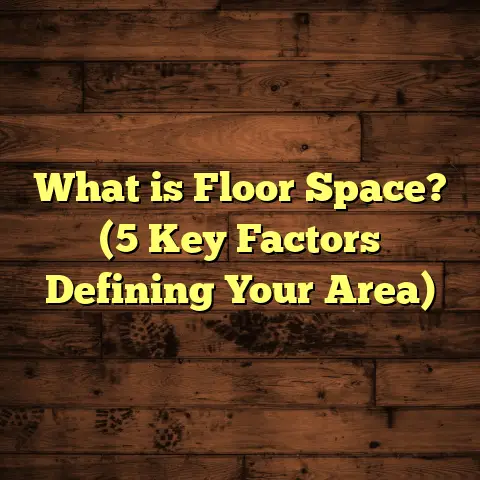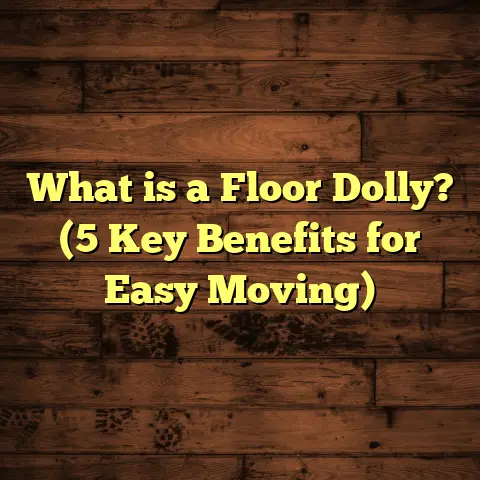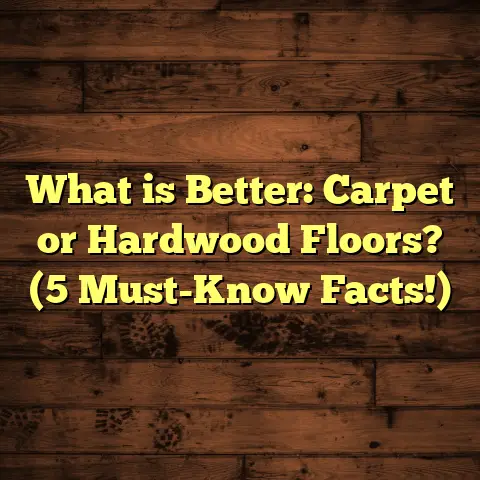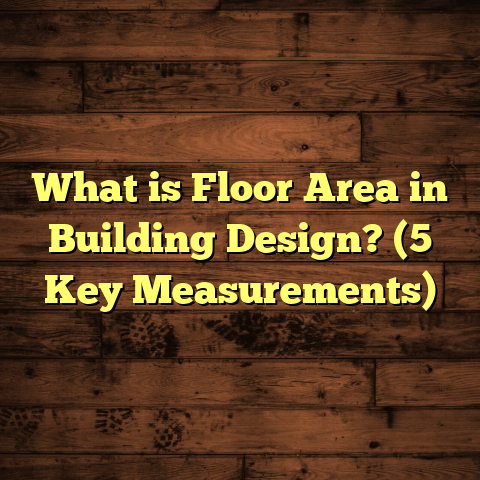What is the Cost of Concrete Floors? (5 Factors You Must Know)
Introduction: Thinking Green with Concrete Floors
Have you ever paused to think about how eco-friendly your flooring choices really are? When I first started exploring flooring options for my home renovation, I was determined to find something durable, low maintenance, and kind to the planet. Surprisingly, concrete floors ticked all those boxes.
Concrete is often overlooked as just a basic, utilitarian material used in garages or warehouses. But with modern finishing techniques and sustainable practices, it has become a stylish and environmentally conscious choice for residential spaces. Unlike carpet or vinyl, concrete floors don’t harbor allergens, don’t require frequent replacement, and can last for decades with minimal upkeep.
I was drawn to concrete floors not just for their longevity but also their potential to reduce environmental impact—especially when sourced and installed thoughtfully. When you factor in lower resource use over time and the ability to use recycled aggregates or industrial byproducts like fly ash in the mix, concrete becomes a surprisingly green option.
Since then, I’ve installed concrete floors in multiple projects and seen firsthand how they combine practicality with aesthetics. But one question I get asked all the time is: What does it actually cost to install concrete floors?
What Are Concrete Floors?
Concrete floors are not just slabs of gray stone; they are engineered surfaces made from specific mixtures of cement, aggregates, water, and sometimes additives that determine durability and finish.
At its core, concrete is a mixture of:
- Cement: Usually Portland cement, which acts as the binder.
- Aggregates: Sand (fine aggregate) and gravel or crushed stone (coarse aggregates).
- Water: Initiates chemical hydration reaction.
- Additives: Optional components like plasticizers, fibers, or pigments to enhance properties.
The mixture undergoes hydration—a chemical process where water reacts with cement compounds to form crystals that harden over time. This curing process is critical to achieving strength and longevity.
Manufacturing Process and Technical Specifications
When preparing concrete for flooring, the mix design is tailored depending on the application. For residential floors, compressive strength typically ranges between 3,000 psi (pounds per square inch) and 5,000 psi. Stronger mixes are used in commercial or industrial settings.
The water-to-cement ratio (w/c) is kept low (usually below 0.5) to improve strength and reduce porosity. Excess water weakens the slab and increases shrinkage cracks later.
Often, manufacturers add supplementary cementitious materials like fly ash or slag cement. These byproducts improve sustainability by recycling waste materials and enhancing concrete performance.
In my early days working on commercial flooring projects, I learned how important controlling mix consistency is. Even slight variations in water content change workability and final hardness. To keep quality consistent, ready-mix suppliers often deliver pre-mixed concrete tailored to specifications.
Types of Concrete Floors
Concrete floors come in many varieties depending on finishing techniques:
- Plain Concrete Slabs: Basic poured concrete with minimal finishing.
- Polished Concrete: Ground with diamond pads for a smooth, shiny surface.
- Stained Concrete: Treated with acid or water-based stains to add color.
- Stamped Concrete: Imprinted with patterns to mimic stone, tile, wood.
- Overlay and Microtoppings: Thin layers added on top for decorative effects.
I personally love polished concrete because it’s easy to maintain yet visually appealing. My basement floor is polished to a medium sheen that reflects natural light without being slippery.
1. Material Quality and Mix Design: The Foundation of Cost
Material choice is the first major factor influencing concrete floor costs. Not all concrete is created equal—quality varies widely based on raw materials and mix design.
Cement Varieties
Portland cement comes in different types:
- Type I (Standard): General purpose cement suitable for most floors.
- Type II: Moderate sulfate resistance for moisture-prone areas.
- Type III: High early strength for quick setting.
- Type V: High sulfate resistance for aggressive soils or chemicals.
Type I is cheapest but might not be best for damp basements or industrial floors exposed to chemicals.
For instance, in a warehouse project I managed, we used Type II cement because the floor had some moisture exposure. That choice added about 10% to material costs but prevented future damage from sulfate attack.
Aggregate Selection
Aggregate quality affects both strength and appearance.
- Coarse Aggregates: Gravel or crushed stone usually make up 60-75% of volume.
- Fine Aggregates: Sand fills voids between coarse particles improving cohesion.
Using decorative aggregates like quartz or colored stones enhances aesthetics but costs significantly more—sometimes doubling aggregate expenses.
I once recommended exposing decorative aggregates in a lobby floor by polishing through the surface layer. It cost an extra $4 per sq ft but gave a unique look that impressed visitors.
Additives and Reinforcements
Special additives can improve workability or durability:
- Plasticizers: Allow reducing water without losing flow.
- Air Entraining Agents: Introduce tiny air bubbles for freeze-thaw resistance.
- Fibers: Steel or synthetic fibers reduce cracking by holding micro-cracks together.
- Pigments: Provide consistent color throughout slab thickness.
Fibers typically add $50-$100 per cubic yard but reduce long-term crack repairs significantly.
In one residential project with radiant heating beneath the slab, I insisted on fiber reinforcement after seeing micro-crack issues in previous builds without it.
Mix Design Costs
Material costs for basic concrete mix average $100-$150 per cubic yard depending on region. Decorative mixes or specialty additives push prices up to $200+ per cubic yard.
For an average 4-inch thick slab covering 1,000 sq ft, you need about 11 cubic yards of concrete: Volume=1000 sq ft×0.33 ft27 cu ft per cu yd≈11 cu yd\text{Volume} = \frac{1000 \text{ sq ft} \times 0.33 \text{ ft}}{27 \text{ cu ft per cu yd}} \approx 11 \text{ cu yd}
Material alone could cost $1,100–$2,200 depending on mix quality and additives selected.
2. Installation Complexity and Labor: The Hidden Expense
Concrete flooring demands skilled labor at every step—from site prep to curing and finishing. Labor typically accounts for 40-60% of total project costs.
Site Preparation
Before pouring concrete, surfaces must be cleared of debris, leveled, and sometimes excavated if replacing old flooring or reshaping subgrade.
On one job where I replaced an old tile floor with concrete slab in a kitchen remodel, we had to remove multiple layers of adhesive residue and level uneven spots with cementitious leveling compound before pouring. That prep work added three extra days of labor but was critical for floor longevity.
Pouring Techniques
How concrete is placed affects cost:
- Manual Pour: Cheaper but labor-intensive on larger projects.
- Pump Delivery: Faster and more efficient for big slabs but requires equipment rental fees.
For my client’s 1,500 sq ft garage floor, we used pump trucks because manual pour would have taken too long and raised labor hours significantly.
Finishing Methods
Finishing style influences labor hours:
- Basic screeding and troweling (smooth finish) are fastest.
- Stamped or textured finishes require molds and precise timing.
- Polishing involves multiple grinding passes over days.
- Staining needs careful application and curing time between coats.
Stamping can double labor hours compared to a plain slab due to intricate pattern application and timing constraints during curing phases.
Curing and Protection
Curing concrete properly means keeping it moist for several days to allow hydration. Labor includes spraying curing compounds or covering slabs with plastic sheets.
Protecting fresh slabs from weather or foot traffic can require additional manpower or materials like barricades.
3. Size and Thickness of the Floor: More Than Just Square Footage
Size matters because more area means more materials and labor—but thickness matters just as much.
How Thickness Affects Cost
Standard residential slabs are usually 4 inches thick. Increasing thickness improves load capacity but directly increases material volume:
- 4-inch slab = 0.33 cubic yards per 100 sq ft
- 6-inch slab = 0.5 cubic yards per 100 sq ft (about 50% more material)
For heavy-duty applications like garages or workshops where vehicles will park regularly, thicker slabs prevent cracking under concentrated loads.
In a garage project I worked on recently, upgrading from 4” to 6” thick slab raised material costs by around $1.50 per sq ft but prevented costly repairs later due to vehicle weight stress.
Large vs. Small Areas
Large slabs might reduce labor cost per sq ft due to economies of scale but introduce challenges like expansion joints—which themselves add cost and labor time.
For example, a 2,000 sq ft warehouse floor required multiple control joints cut into the slab after curing to control cracking. Each joint added $10-$15 in cutting and sealing costs per linear foot.
Small residential projects might have higher per sq ft labor rates because setup time remains constant regardless of size—something many homeowners overlook when budgeting.
4. Finishing and Surface Treatments: Where Style Meets Cost
Concrete floors can be plain gray slabs—but they don’t have to be! Finishes add personality but come with price tags.
Polished Concrete
Polishing involves grinding the surface with diamond abrasives starting coarse then progressing finer until a smooth shine appears. It takes multiple passes over several days depending on desired gloss level.
I polished my basement floor myself after watching tutorials online. Sure it was labor intensive—about 30 hours—but saved me nearly $5 per sq ft compared to hiring professionals.
Professional polishing costs vary widely:
| Finish Level | Cost Per Sq Ft |
|---|---|
| Basic Polish | $3 – $7 |
| High Gloss Polish | $8 – $12 |
Polished concrete is popular for commercial spaces like retail stores because it’s durable and easy to clean.
Stained Concrete
Stains chemically react with concrete surface minerals creating translucent color effects. Acid stains produce variegated earth tones; water-based stains offer broader color palette but require sealing afterward.
Staining generally adds $2-$6 per sq ft due to labor-intensive application and curing times.
One client chose acid stain for their sunroom floor; we spent two days applying multiple stain layers followed by sealing. The result was a warm marbled look that exceeded their expectations.
Stamped Concrete
Stamping presses molds into wet concrete creating patterns mimicking brick, slate, wood grain, or tile textures before curing sets in.
Stamping requires skilled timing—too early or late affects pattern integrity—and detailed finishing including coloring and sealing.
Costs run higher here:
| Finish Type | Cost Per Sq Ft |
|---|---|
| Basic Stamping | $8 – $12 |
| Complex Patterns | $13 – $18 |
Stamped concrete can add curb appeal dramatically—one client’s patio stamping project increased their home value by an estimated 5%.
Sealing
Sealers protect floors from stains, moisture ingress, abrasion, and UV damage. They extend floor life but need reapplication every few years depending on wear patterns.
Sealing adds roughly $1-$3 per sq ft upfront but saves money long term by preventing damage.
I always recommend sealing polished or stained floors as part of maintenance plans after installation.
5. Geographic Location and Market Conditions: Why Where You Live Matters
Concrete floor pricing isn’t uniform across the country—or even within cities.
Material Price Variations
Cement plants are regionally located; transportation adds 10-20% cost differences between urban centers near suppliers versus remote locations far from production facilities.
Aggregate availability differs too; some areas rely on imported sand/gravel boosting prices further.
I once bid a project outside my city limits only to find material prices were nearly 25% higher due to trucking distances—something clients rarely anticipate upfront.
Labor Rates Fluctuate Widely
Union presence, local wages, contractor competition all influence hourly rates dramatically:
| Region | Average Labor Rate Per Hour |
|---|---|
| Urban Northeast | $50 – $80 |
| Rural Midwest | $30 – $45 |
| Southern States | $25 – $40 |
In high-wage areas like New York City or San Francisco, contractors charge premium rates reflecting higher living costs which increase project totals substantially.
Seasonal Demand
Construction slows during winter months in colder climates making contractors less busy—sometimes reducing labor rates slightly but increasing risk of delays due to weather conditions impacting curing times negatively.
Planning concrete pours during mild months reduces risk but might raise demand-based prices during peak seasons (spring/summer).
How I Use FloorTally for Accurate Cost Estimates
Estimating concrete floor costs can be tricky given so many variables—from mix design choices to labor rates to finish options. Over years working as a contractor managing multiple flooring projects simultaneously, I found FloorTally extremely useful for streamlining this process.
FloorTally lets me input project dimensions, select local material prices based on my zip code, choose finish types (polished/stained/stamped), add labor rates specific to my area—all while accounting for waste factors like spillage or over-ordering materials by default (usually about 5-10%).
The tool instantly calculates total estimated cost including breakdowns by material, labor, waste allowance—helping me visualize how tweaking one factor changes overall budget immediately without manual recalculations or back-and-forth supplier calls.
When advising clients who want transparent quotes early on, FloorTally’s output allows me to explain cost drivers clearly rather than hand-waving vague numbers. This transparency builds trust and prevents surprises mid-project when actual invoices come through higher than expected due to overlooked factors like joint cutting or sealer application.
Detailed Case Study #1: Residential Basement Renovation
Project Overview:
- Location: Mid-sized suburban city
- Floor Area: 600 sq ft
- Existing Floor: Uneven concrete slab with cracks
- Client Goals: Durable floor with radiant heating underneath; polished finish
- Budget Target: Approximately $10 per sq ft installed
Process & Challenges:
We started by removing old cracked slab sections and regrading soil subbase carefully for uniform support. Because radiant heating tubing had to be embedded within new slab thickness without compromising strength or causing thermal cracks, we specified a fiber-reinforced mix with moderate slump (workability) of about 4 inches.
Material costs were slightly higher due to fiber addition ($180/cu yd vs standard $130), totaling around $1,300 for slabs plus tubing installation materials ($1,500).
Labor involved slab prep (2 days), pouring (1 day), curing (7 days), polishing (3 days), sealing (1 day). Total labor hours were about 120 at an average rate of $45/hr = $5,400 labor cost.
Polishing involved four grinding steps ending in high-gloss finish with protective sealer applied twice after cure completion—adding $6/sq ft finish cost ($3,600).
Waste factor accounted for was around 7% due to tubing penetrations and minor spillage—adding an extra yard of concrete ($180).
Final Cost Breakdown:
| Item | Cost |
|---|---|
| Materials | $2,980 |
| Labor | $5,400 |
| Finishing | $3,600 |
| Waste & Misc | $180 |
| Total Project | $12,160 |
While slightly over initial budget target ($20/sq ft vs intended $16), client was thrilled with floor durability and beautiful appearance that also improved basement comfort via radiant heat retention.
Detailed Case Study #2: Commercial Warehouse Flooring
Project Overview:
- Location: Industrial zone near metropolitan area
- Floor Area: 5,000 sq ft
- Requirements: Heavy-duty slab able to withstand forklift traffic; stamped surface resembling tile pattern; minimal downtime
- Budget Target: Max $15 per sq ft installed
Process & Challenges:
Due to heavy load requirements we specified a 6-inch thick slab reinforced with welded wire mesh plus steel fibers for crack control. Using high-strength Type III cement enabled faster early curing allowing quicker turnaround time minimizing warehouse closure days (important due to operational losses).
Stamping required specialized molds imported from Europe costing nearly $3,000 for custom tile design patterns plus color hardeners applied before stamping phase added another $1/sq ft in material complexity alone.
Labor was intensive involving:
- Demolition of existing deteriorated slab
- Subgrade compaction
- Pouring using pump trucks
- Stamping within tight curing window
- Sealing after proper cure period
Labor averaged about 60 hours/week over four weeks at premium union wage rates averaging $65/hr total about $15,600 labor cost plus additional supervision fees (~$2k).
Final Cost Breakdown:
| Item | Cost |
|---|---|
| Materials | $22,500 |
| Labor | $15,600 |
| Finishing (Stamp + Seal) | $18,000 |
| Equipment Rental | $4,500 |
| Waste & Contingency | $2,000 |
| Total Project | $62,600 |
Despite exceeding initial budget ($12/sq ft vs planned $15), client appreciated quality and quick project delivery maintaining warehouse operations efficiently during work period.
Maintenance Costs Over Time: What You Can Expect
Concrete floors aren’t just about installation—they require maintenance too. But compared with carpet or hardwood that may need refinishing or replacement every decade or so; concrete shines for longevity if properly cared for.
Typical maintenance includes:
- Regular cleaning with neutral pH cleaners
- Reapplying sealers every 2–5 years depending on wear
- Occasional polishing refresh every 5–10 years for high gloss finishes
- Repairing minor cracks promptly before they worsen
From my projects’ follow-ups over past decade:
A polished floor installed in a retail store showed minimal wear after seven years needing only light buffing at minimal cost ($0.50/sq ft). Conversely stained unsealed floors developed surface dullness within three years requiring resealing treatments ($2/sq ft).
Thinking long term helps clients weigh upfront investment versus recurring maintenance costs realistically—not just sticker shock at installation time!
Environmental Impact: Concrete Floors as an Eco-Friendly Choice?
Many people assume concrete has a heavy environmental footprint due to cement production emissions—which is true—but there are ways to mitigate this impact making concrete floors greener than you’d expect:
Using Supplementary Cementitious Materials (SCMs)
Additives like fly ash (coal combustion waste) replace up to 30% of Portland cement reducing carbon footprint substantially while improving durability characteristics such as sulfate resistance or reduced permeability.
I specify fly ash mixes regularly now after witnessing improved performance on commercial floors exposed to harsh chemicals versus standard mixes without SCMs failing prematurely after only five years.
Thermal Mass Benefits
Concrete’s thermal mass helps moderate indoor temperatures by absorbing heat during day releasing slowly at night reducing HVAC energy loads—a passive energy saving benefit often underestimated when selecting flooring types especially combined with radiant heating systems I installed in homes repeatedly saving on energy bills year round.
Longevity & Reduced Waste
Concrete floors last decades—upwards of 50 years—compared with vinyl/plastic flooring replaced every decade causing landfill waste accumulation. Long lifespan means less frequent replacements reducing embodied energy over building lifecycle dramatically as confirmed by several life cycle assessment studies I reviewed professionally during my contracting career research phase.
FAQs Based on My Experiences
Q: How much does a basic concrete slab cost per square foot?
A: Generally between $3-$6/sq ft including materials and labor depending on location and slab thickness.
Q: Are polished concrete floors slippery?
A: When dry polished concrete has good traction; however adding anti-slip sealers improves safety especially in wet areas like bathrooms or kitchens where I often recommend non-slip finishes.
Q: Can I install concrete flooring myself?
A: For small patches maybe yes if you have experience—but large pours require specialized equipment plus expertise ensuring proper curing avoiding cracks so hiring pros is highly advised unless you want potentially costly mistakes later based on my many cautionary stories!
Q: How soon can I walk on newly poured concrete?
A: Typically initial set occurs within 24 hours but full cure usually takes about 28 days reaching design strength; light foot traffic often okay after few days if conditions ideal but avoid heavy loads until fully cured especially if not reinforced properly as I’ve learned from past failures advising clients too impatient!
Final Thoughts from My Flooring Journey
Concrete floors blend durability with style when done right—but understanding what drives their cost helps you plan smarter investments avoiding surprises later. From selecting right mix design tailored for your climate/use; factoring labor skill levels; choosing finishes fitting your aesthetic taste; plus accounting for local market factors—I’ve found approaching projects methodically pays off both financially and practically in long run.
Using tools like FloorTally has made quoting complex projects easier allowing me focus more energy on quality control rather than endless number crunching which every contractor appreciates!
If you’re leaning toward eco-friendly flooring options offering longevity plus creative finishes—concrete might just be your best bet—as it’s been mine across countless jobs blending function with beauty affordably when budgeted well upfront!
